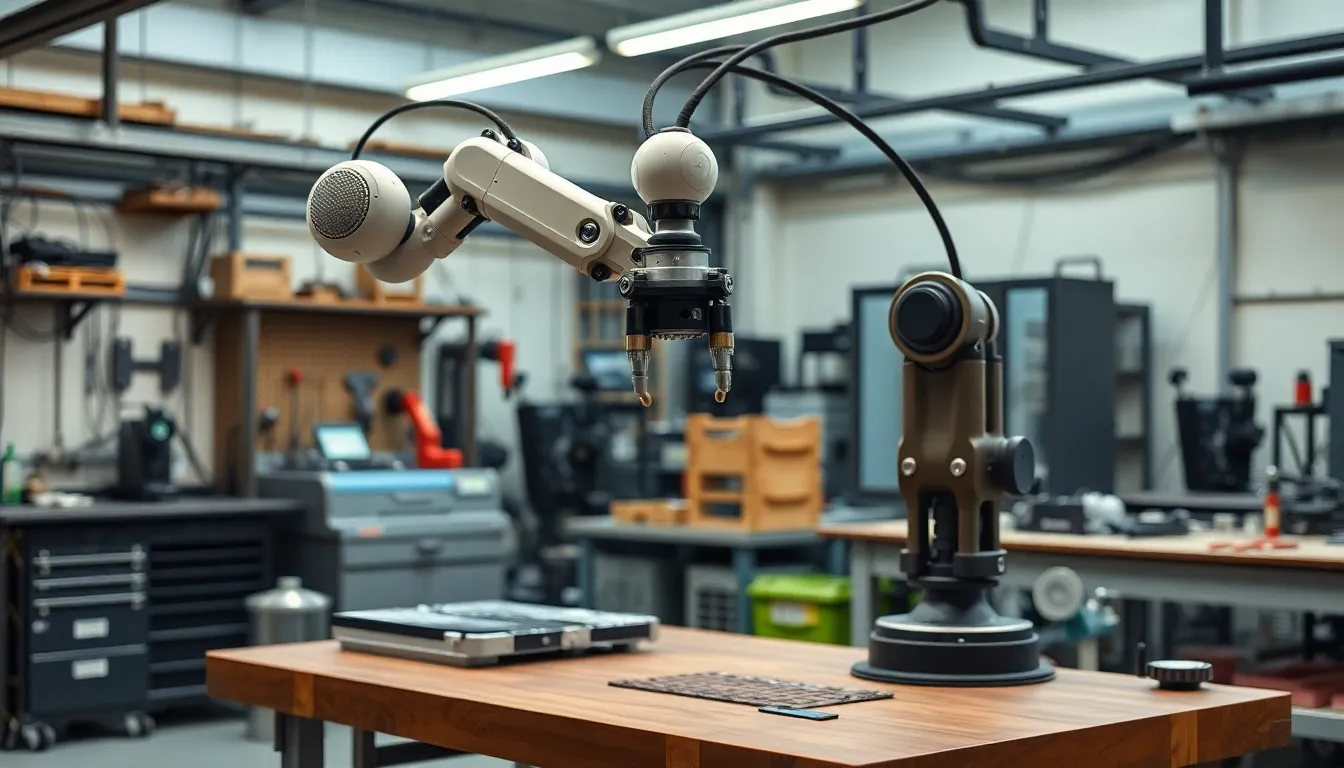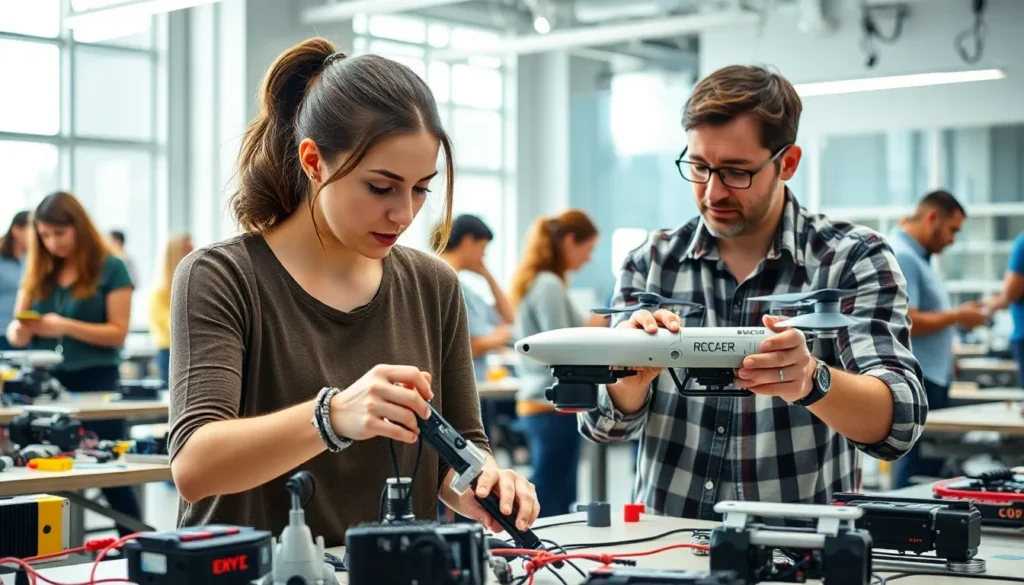In a world where robots are no longer just the stuff of science fiction, robotic tools and resources have become essential for businesses and hobbyists alike. Imagine a future where your coffee is brewed by a robot while it simultaneously organizes your sock drawer. Sounds dreamy, right? With the rapid advancement of technology, these tools are not only making life easier but also adding a sprinkle of fun to everyday tasks.
Table of Contents
ToggleOverview of Robotic Tools and Resources
Robotic tools significantly enhance efficiency and effectiveness in various tasks. They cater to the needs of both professional environments and personal projects.
Definition of Robotic Tools
Robotic tools encompass a wide range of devices designed to automate tasks. These instruments include robotic arms, drones, and autonomous vehicles. They rely on programmable software that allows them to perform specific functions. Industrial robots streamline manufacturing processes, while hobbyist kits enable enthusiasts to build custom robots. With the help of sensors and artificial intelligence, robotic tools can adapt to different tasks and environments.
Importance of Resources in Robotics
Resources play a crucial role in advancing robotic technology. Access to high-quality components accelerates development and innovation. Knowledge resources, such as research papers and online tutorials, empower engineers and hobbyists to enhance their skills. Communities dedicated to robotics provide support and share insights, fostering collaboration. Additionally, funding opportunities and grants can drive research projects and product development. Investing in resources strengthens the foundation for robotics, ensuring continued growth and sophistication in the field.
Types of Robotic Tools

Robotic tools encompass various devices that streamline tasks and enhance productivity across multiple sectors.
Mechanical Tools
Mechanical tools refer to physical devices that perform specific functions. Robotic arms serve as crucial examples, enabling precision in assembly lines and surgical procedures. Drones excel in aerial photography and surveillance, offering unique perspectives and data collection capabilities. Autonomous vehicles automate transportation, improving logistics and reducing human error. Each of these tools plays a vital role in increasing efficiency and accuracy.
Software Tools
Software tools are essential for programming and controlling robotic devices. Simulation software allows engineers to design and test robotic systems before implementation. Development platforms such as ROS (Robot Operating System) provide frameworks for building applications, enabling flexibility and ease of use. Machine learning algorithms empower robots to learn from data, enhancing their ability to adapt to new environments. Together, these tools facilitate the integration of robotics into various applications.
Educational Resources
Educational resources significantly impact the growth of robotics. Online courses offer comprehensive training in robotics design and programming. Books provide in-depth knowledge about theories and applications, serving as reliable references. Community forums connect enthusiasts and professionals, fostering collaboration and knowledge sharing. Access to these resources cultivates innovation and supports continuous learning in the ever-evolving field of robotics.
Applications of Robotic Tools
Robotic tools play a significant role across various sectors, enhancing efficiency and precision. Their capabilities extend into industrial, healthcare, and educational environments.
Industrial Automation
Automation in industries revolutionizes manufacturing processes. Robots perform repetitive tasks like assembly, welding, and packaging with high accuracy. Data from the International Federation of Robotics indicates that manufacturing companies utilizing robots see productivity gains of up to 30%. Companies deploy robotic arms to handle intricate tasks, reducing human error and improving safety. Flexible automation systems allow businesses to scale operations rapidly in response to market demands.
Healthcare
In healthcare, robotic tools assist in surgeries and patient care. Surgical robots increase precision during operations, leading to shorter recovery times for patients. Data from the American College of Surgeons shows that minimally invasive surgeries performed with robotic assistance result in 50% less blood loss. Additionally, robots enhance patient monitoring and rehabilitation, providing consistent care. Artificial intelligence drives improvements in diagnostics and treatment planning, supporting healthcare providers in making informed decisions.
Education and Training
Educational institutions incorporate robotic tools to enhance learning experiences. Robotics programs engage students in science, technology, engineering, and mathematics (STEM). Access to robotic kits enables students to build and program their devices, promoting hands-on learning. Research from the Robotics Education & Competition Foundation demonstrates that students participating in robotics competitions exhibit higher problem-solving skills and critical thinking. Furthermore, online platforms and community forums provide resources for continuous learning, preparing individuals for future careers in robotics.
Challenges in Utilizing Robotic Tools
Robotic tools present various challenges that hinder widespread adoption and effective utilization in different settings.
Cost and Accessibility
Costs associated with robotic tools can be prohibitive. Many high-quality robotic systems require significant upfront investments for both purchasing and maintaining the equipment. Accessibility is often limited by geographical factors as well. Remote areas may lack the necessary infrastructure or support to facilitate the integration of these technologies. Organizations focused on innovation often seek funding opportunities to alleviate financial burdens. Educational institutions, in particular, face challenges in acquiring advanced robotic kits due to budget constraints. Striking a balance between innovation and affordability remains a key challenge in enhancing accessibility.
Technical Expertise
A notable challenge stems from the need for specialized knowledge to operate robotic tools effectively. Programming and maintaining robotic systems require technical skills that may not be readily available in all organizations. Many individuals lack familiarity with crucial programming languages and software, creating a barrier to entry for new users. Training programs and workshops can help bridge this skills gap. Organizations investing in employee education often achieve greater success with robotic integration. Furthermore, advancements in machine learning can facilitate user-friendly interfaces that simplify operation, yet initial expertise remains a hurdle in widespread adoption.
Future Trends in Robotic Tools and Resources
Innovations in robotic tools are set to reshape the landscape of technology in the coming years. Increased focus on automation and artificial intelligence will drive these advancements.
Advancements in Technology
Robotics technology sees rapid progress with developments in artificial intelligence, machine learning, and sensor technology. These advancements allow robots to perform complex tasks with enhanced precision. Improved algorithms are making it easier for robots to understand and navigate their environments. Additionally, more efficient batteries enable longer operation times, increasing the utility of robotic tools. Enhanced user interfaces simplify programming, making robotic devices accessible to a broader audience. Technologies like 5G are also facilitating real-time data processing and communication, further improving operational efficiency.
Impact on Various Industries
Various industries are experiencing significant transformations due to robotic tools. Manufacturing sectors report an increase in productivity, with robots performing repetitive tasks more efficiently than human workers. In healthcare, robotic surgery systems result in precise outcomes, reducing patient recovery times. Educational institutions now incorporate robotics into curricula, facilitating interactive learning experiences. Logistics companies utilize autonomous vehicles for timely deliveries, cutting operational costs. Agriculture embraces drones and automated systems to optimize crop management efficiently. As robotic tools continue to evolve, economic growth across these sectors appears inevitable.
The integration of robotic tools is reshaping everyday life and various industries. As technology advances, these tools are becoming essential for enhancing efficiency and productivity. Access to quality resources and community support plays a critical role in fostering innovation within the field.
While challenges like high costs and the need for specialized skills exist, solutions are emerging to bridge these gaps. The future of robotics is promising, with ongoing developments in AI and machine learning set to revolutionize how these tools are utilized. As they continue to evolve, robotic tools will undoubtedly have a lasting impact on society, making tasks easier and driving growth across multiple sectors.





